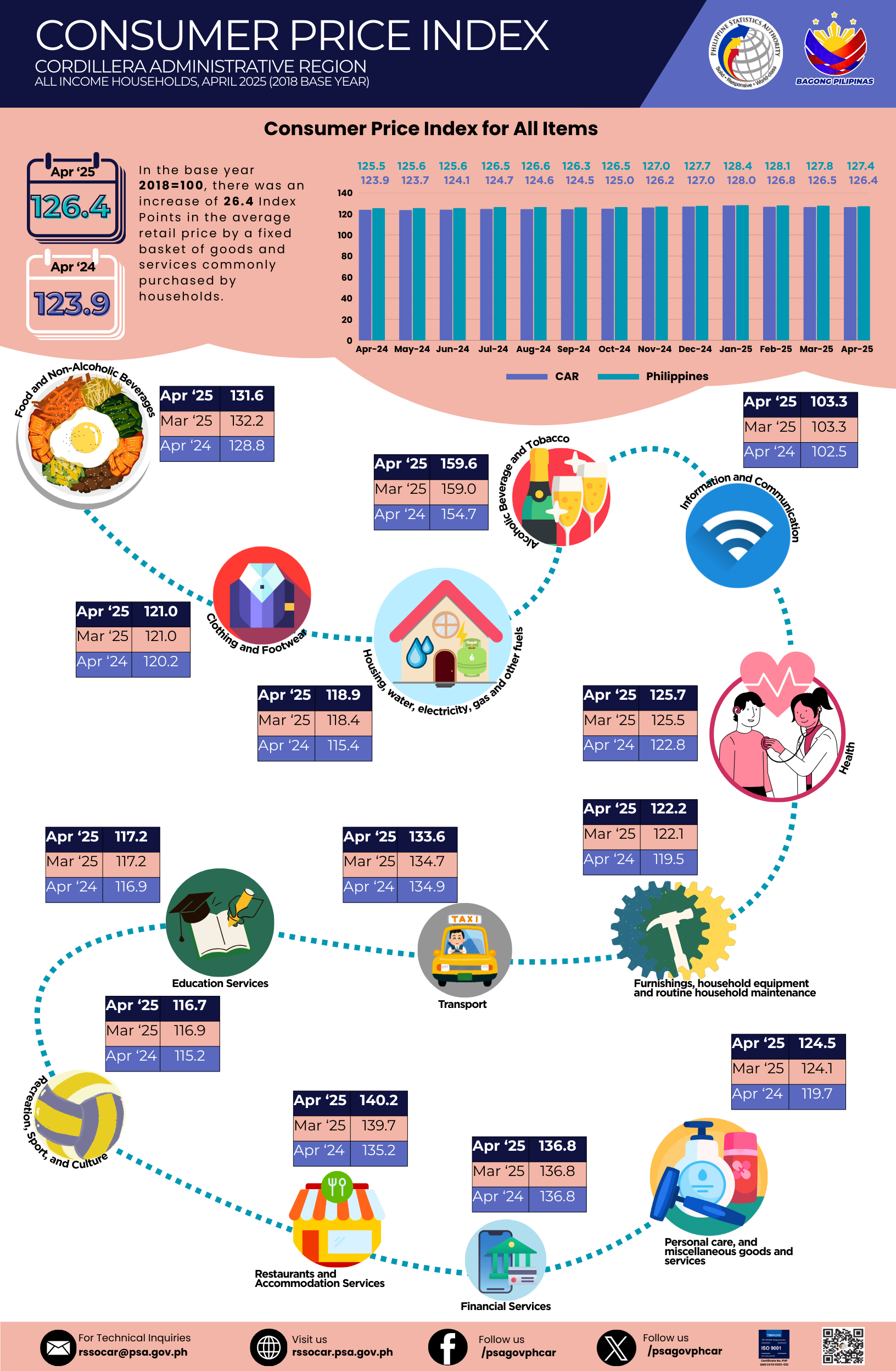Figure 1. Inflation Rate for the All Income and Bottom 30 Percent Income Households in CAR, All Items: In Percent
July 2024 - July 2025 (2018=100)
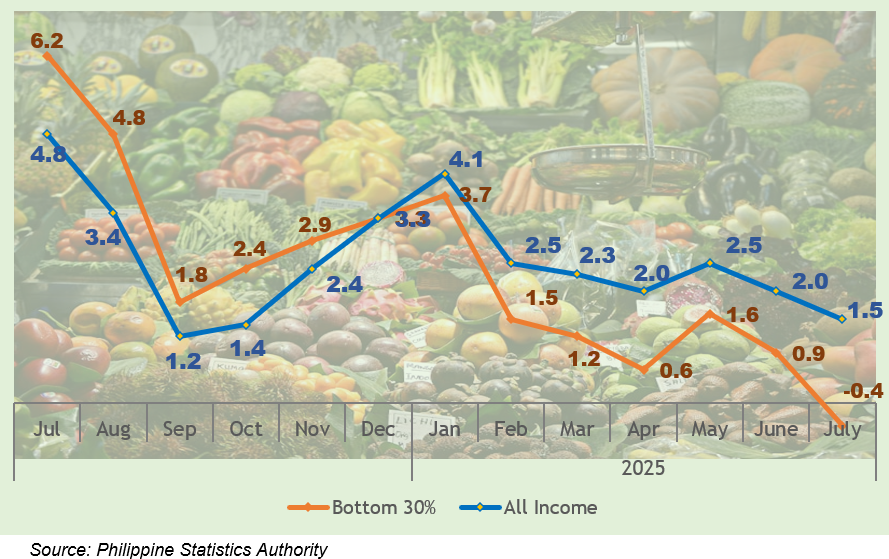
1. Cordillera Administrative Region
In July 2025, the inflation rate for the bottom 30 percent income households in CAR, decelerated to -0.4 percent, down from 0.9 percent in June 2025. Except for May 2025, which recorded an increase from the previous month, the inflation rate for both all income households and the bottom 30 percent income households showed a consistent decline throughout 2025 (Table 1 and Figure 1).
1.1 Main Driver to the Downward Trend of Inflation
The downward trend in inflation was primarily driven by the Food and Non-Alcoholic Beverages commodity group, which posted an inflation rate of -1.3 percent in July 2025, down from 0.2 percent in June 2025. This commodity group contributed 55.3 percent to the overall downtrend in inflation for the region’s bottom 30 percent income households (Table 1 and Figure 1).
Table 1. Year-on-Year Inflation Rates for Bottom 30 Percent Income Households
by Commodity Group in CAR, All Items: In Percent
July 2024, June 2025, July 2025
(2018=100)
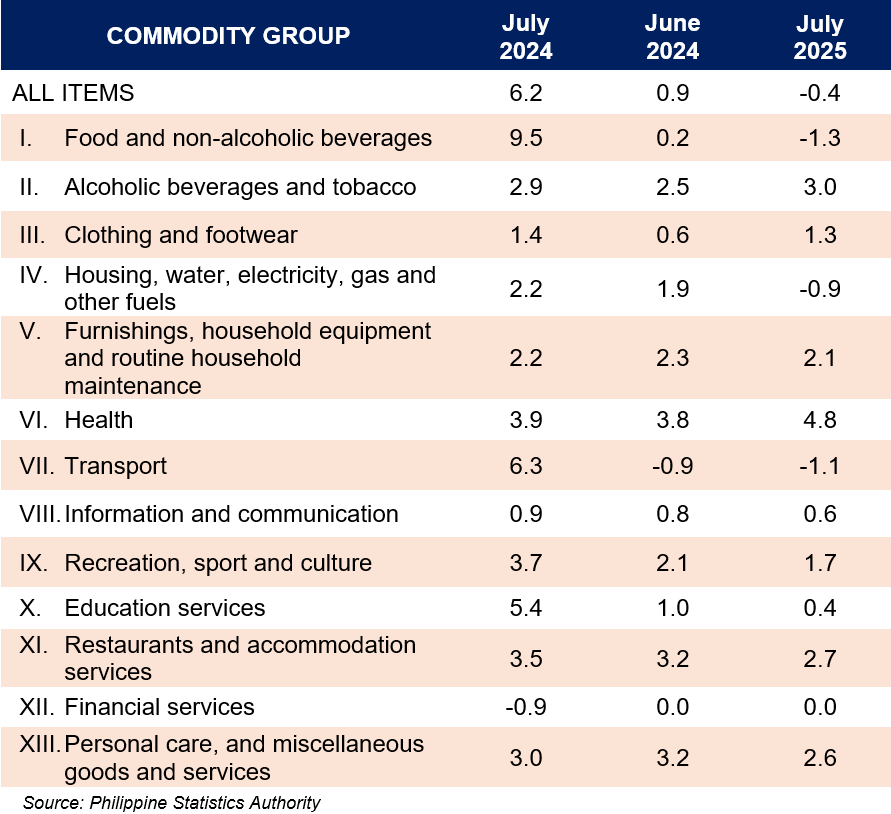
Additional contributors to the deceleration include:
a. Housing, Water, Electricity, Gas and Other Fuels: -0.9 percent (from 1.9 percent)
b. Furnishings, Household Equipment and Routine Household Maintenance: 2.1 percent (from 2.3 percent)
c. Information and Communication and Education Services: 0.6 percent (from 0.8 percent)
d. Recreation Sports and Culture, Education Services: 1.7 percent (from 2.1 percent)
e. Education Services: 0.4 (from 1.0 percent)
f. Restaurants and Accommodation Services: 2.7 percent (from 3.2 percent)
g. Personal Care, and Miscellaneous Goods and Services: 2.6 percent (from 3.2 percent)
A faster negative inflation rate was recorded for:
a. Transport: -1.1 percent (from -0.9 percent)
In contrast, the following commodity groups posted higher inflation rates in July 2025:
a. Alcoholic Beverages and Tobacco: 3.0 percent (from 2.5 percent)
b. Clothing and Footwear: 1.3 percent (from 0.6 percent)
c. Health: 4.8 (from 3.8 percent)
Meanwhile, Financial Services maintained a constant inflation rate of 0.0 percent.
1.2 Top Three (3) Contributors to Inflation for the Bottom 30 percent Income Households
The top three contributors to the -0.4 percent overall inflation rate for the bottom 30 percent income households in CAR were:
a. Food and Non-Alcoholic Beverages:165.2 percent share of the total inflation, contributing -0.7 percentage points
b. Housing, Water, Electricity, Gas and Other Fuels: 40.6 percent share of the total inflation, contributing -0.2 percentage points
c. Transport: 17.6 percent share of the total inflation, contributing -0.1 percentage points
2. Food Inflation in CAR
In July 2025, food inflation for the bottom 30 percent income household in CAR decelerated to -1.6 percent, down from 0.2 percent in June 2025. This commodity group accounted for 185.6 percent of the total inflation, contributing -0.7 percentage points to the overall inflation rate of -0.4 percent for the month. In comparison, food inflation was recorded at 9.7 percent in July 2024 (Table 2).
2.1 Main Drivers of the Downward Trend in Food Inflation
The decline in food inflation was primarily driven by a sharper negative inflation in rice, which posted -11.6 percent inflation in July 2025, compared to -8.8 percent in June. This group contributed 59.4 percent to the deceleration in food inflation for the bottom 30 percent income households (Table 2).
Table 2. Year-on-Year Inflation Rates for Bottom 30 percent Income Households
by Food Group in CAR, All Items: In Percent
July 2024, June 2025-July 2025
(2018=100)
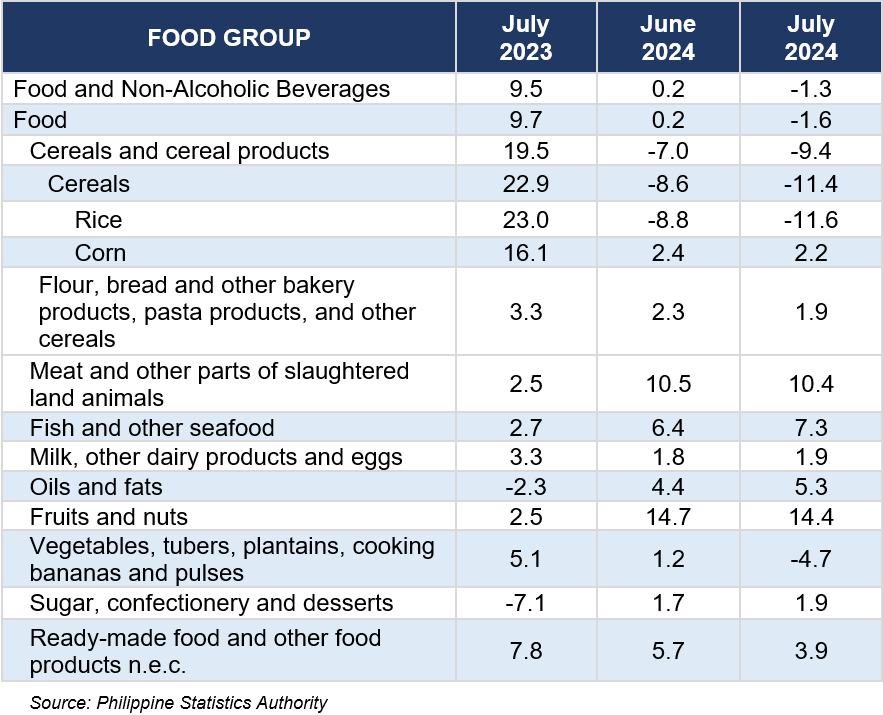
Slower inflation rates were also observed in the following food items:
a. Corn: 2.2 percent (from 2.4 percent)
b. Flour, bread and other bakery products, pasta products, and other cereals: 1.9 percent (from 2.3 percent)
c. Meat and Other Parts of Slaughtered Land Animals: 10.4 percent (from 10.5 percent)
d. Fruits and nuts: 14.4 percent (from 14.7 percent)
e. Vegetables, tubers, plantains, cooking bananas and pulses: -4.7 percent (from 1.2 percent)
f. Ready-made food and other food products n.e.c,: 3.9 percent (from 5.7 percent)
Conversely, faster inflation rates were recorded in the following food groups:
a. Fish and Other Seafood: 7.3 percent (from 6.4 percent)
b. Milk, Other Dairy Products and Eggs: 1.9 percent (from 1.8 percent)
c. Oils and Fats: 5.3 percent (from 4.4 percent)
d. Sugar, Confectionery and Desserts: 1.9 percent (from 1.7 percent)
2.2 Main Contributors to Cordillera Food Inflation
The top three food groups contributing to the -1.6 percent food inflation in July 2025 were:
a. Rice: 272.1 percent share, contributing -4.4 percentage points
b. Vegetables, tubers, plantains, cooking bananas and pulses: 35.5 percent share, contributing 0.6 percentage points
c. Sugar, confectionary and desserts: -3.8 percent share, contributing 0.1 percentage points
3. Provinces/ Highly Urbanized City -HUC) in CAR
In July 2025, slower inflation rates for the bottom 30 percent income households were observed in four provinces and one HUC in CAR:
a. Abra: -0.6 percent (from 4.1 percent)
b. Benguet: 0.9 percent (from 1.0 percent)
c. Baguio City: 2.0 percent (from 2.2 percent)
d. Ifugao: 0.8 percent (from 2.6 percent)
e. Mountain Province: -0.5 percent (from 0.5 percent)
Slower negative inflation:
a. Kalinga: at -1.1 percent from -1.2 percent
Faster negative inflation:
a. Apayao: -5.1 percent (from -3.5 percent)
Among the provinces and HUC in CAR, Baguio City recorded the highest inflation rate at 2.0 percent, while Apayao registered the lowest, with a negative inflation at -5.1 percent (Table 3).
Table 3. Year-on-Year Inflation Rates for Bottom 30 percent Income Households
by Province/City in CAR, All Items: In percent
July 2024, June 2025, & July 2025
(2018=100)
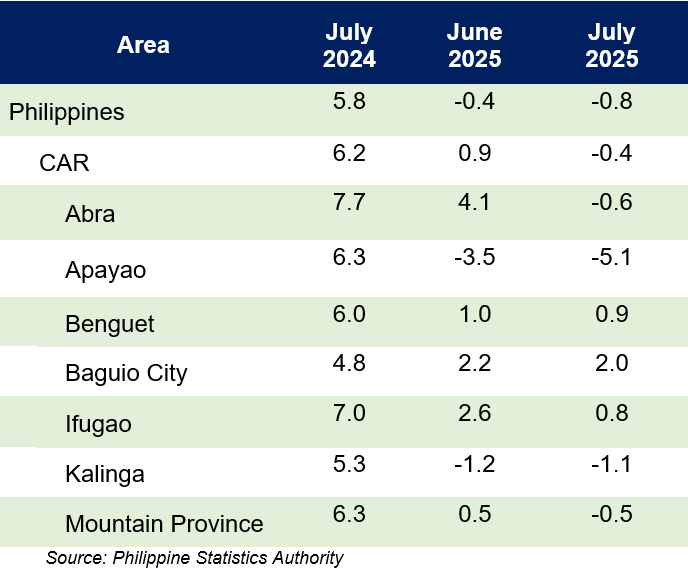
Note:
Detailed CPI and inflation rate data by province and HUCs are available on the PSA website -http://openstat.psa.gov.ph.
(SGD)
VILLAFE P. ALIBUYOG
Regional Director
Designation Initials Date
CSS AFRB 12 August 2025
SuSS WBM 11 August 2025
COSW SCG 05 August 2025
Technical Notes
Base Period a reference period, usually a year, at which the index number is set to 100. It is the reference point of the index number series.
Consumer Price Index -CPI is an indicator of the change in the average retail prices of a fixed basket of goods and services commonly purchased by an average Filipino household. It shows how much on average, prices of goods and services have increased or decreased from a particular reference period known as base year.
Inflation Rate refers to the annual rate of change or the year-on-year change of the CPI expressed in percent. Inflation is interpreted in terms of the declining purchasing power of money.
Market Basket for CPI purposes, market basket is a term used to refer to a sample of goods and services that are commonly purchased and bought by an average Filipino household.
Philippine Classification of Individual Consumption According to Purpose -PCOICOP A detailed classification of individual consumption expenditures on goods and services incurred by the three -household, general government, non-profit institutions serving households of the five institutional sectors -non-financial corporations, financial corporations of the 1993 and 2008 Systems of National Accounts -SNA. The PCOICOP was patterned after the United Nations COICOP.
Purchasing Power of the Peso -PPP shows how much the peso in the base period is worth in the current period. It is computed as the reciprocal of the CPI for the period under review multiplied by 100.
Weight is a value attached to a commodity or group of commodities to indicate the relative importance of that commodity or group of commodities in the market basket.



